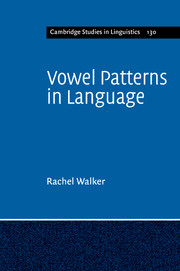Book contents
8 - Maximal licensing
Published online by Cambridge University Press: 26 April 2011
Summary
Introduction
This chapter turns to vowel patterns beyond those driven by prominence-based licensing. Under focus are unbounded harmony systems that involve a trigger that is weak or presents marked structure in some respect. Unlike harmony driven by prominence-based licensing, these patterns do not single out a prominent position as their final target. Instead, they are unbounded, producing assimilation as far as can be achieved while respecting other constraints that may prevent certain vowels from participating. They therefore serve to reduce perceptual difficulty for a vowel property by causing it to be realized in as many syllables as possible.
The proposal pursued in this chapter is that the unbounded systems under study are driven by maximal licensing constraints (building on Kaun 1995, 2004; Walker 2005; Jiménez and Lloret 2007). These constraints assign violations to every vowel (or segment) to which a chain for a given feature in a representation is not associated. They consequently drive harmony that propagates to the maximal extent.
Some differences between vowel harmony driven by prominence-based licensing versus maximal licensing are illustrated in (1). For the prominence-based cases, the stressed syllable serves as the strong licensing position for a feature specification [αF]. The illustrations for prominence-based licensing in (1a) depict some possible scenarios involving weak post-tonic syllables. Either harmony operates from a post-tonic syllable to the stressed syllable or the stressed syllable triggers harmony in post-tonic syllables, as shown in (1ai).
- Type
- Chapter
- Information
- Vowel Patterns in Language , pp. 238 - 296Publisher: Cambridge University PressPrint publication year: 2011



